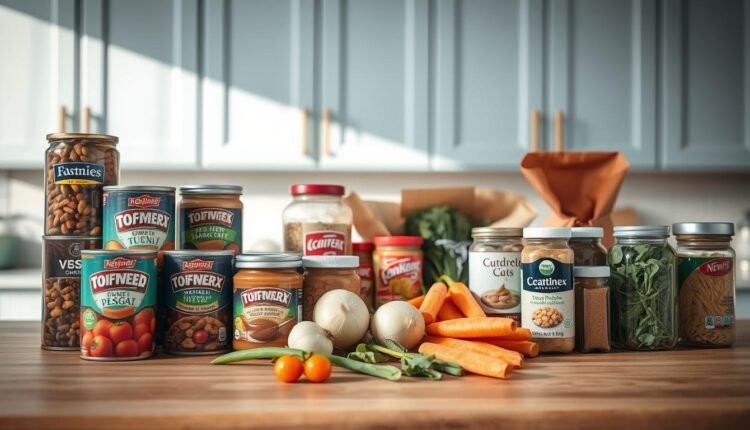Lunch Meal Prep Pantry Staples For Emergency Backups
Discover essential lunch meal prep pantry staples for stress-free meal backups. Learn how to stock your pantry for easy meal prep and grab-and-go lunches.
What do canned tuna and rice have in common? Beyond being kitchen staples, they’re secret weapons for creating quick, nourishing dishes when time runs short or plans change. A well-organized shelf of versatile ingredients transforms chaotic evenings into manageable moments—no last-minute grocery runs required.
During my early days as a busy line cook, I learned that smart storage beats complicated recipes every time. Canned beans become creamy soups. Jarred tomatoes morph into hearty sauces. With a few core items, you can build satisfying bowls, wraps, or casseroles in minutes—perfect for hectic days or unexpected situations.
This guide walks through building a reliable foundation of ingredients that work harder for you. Think of it as your culinary safety net—simple, budget-friendly, and adaptable to whatever the week throws your way.
Key takeaways:
- Core ingredients like grains and proteins offer endless meal possibilities
- Strategic storage cuts decision fatigue during busy weeks
- Budget-friendly solutions adapt to dietary needs and schedules
Stress-Free Lunch Meal Prep
Your kitchen shelves hold the key to effortless, tasty dishes any day of the week. I’ve discovered that keeping versatile ingredients like pasta and canned beans on hand turns chaotic afternoons into calm, creative cooking sessions. Think of it as building a toolkit—one that lets you assemble satisfying meals without staring blankly at an empty fridge.
Web recipes from trusted sources like EatingWell emphasize how shelf-stable items cut cooking time by 40%. For example, whole-grain pasta pairs with chickpeas and olive oil for a protein-packed bowl. Canned beans become instant salads or hearty fillings for wraps. It’s about working smarter, not harder.
As chef Jamie Oliver notes:
“A well-planned cupboard is half the battle won. You’re already halfway to dinner before you start cooking.”
Stick to recipes with five core ingredients or fewer. Batch-cook grains like quinoa on Sundays, then mix with roasted veggies and beans throughout the week. This approach reduces decision fatigue and keeps meals fresh and exciting.
Remember: Flexibility matters more than perfection. Rotate between three base ingredients—like pasta, lentils, and couscous—to avoid boredom. Keep spices bold and portions adaptable. Your future self will thank you when Wednesday’s chaos hits.
Why a Well-Stocked Pantry Matters
Imagine your shelves as a culinary safety net—ready to catch you when hunger strikes or schedules spiral. A thoughtfully stocked collection of ingredients turns “What’s for dinner?” into “How fast can I make this?” without sacrificing nutrition or flavor.
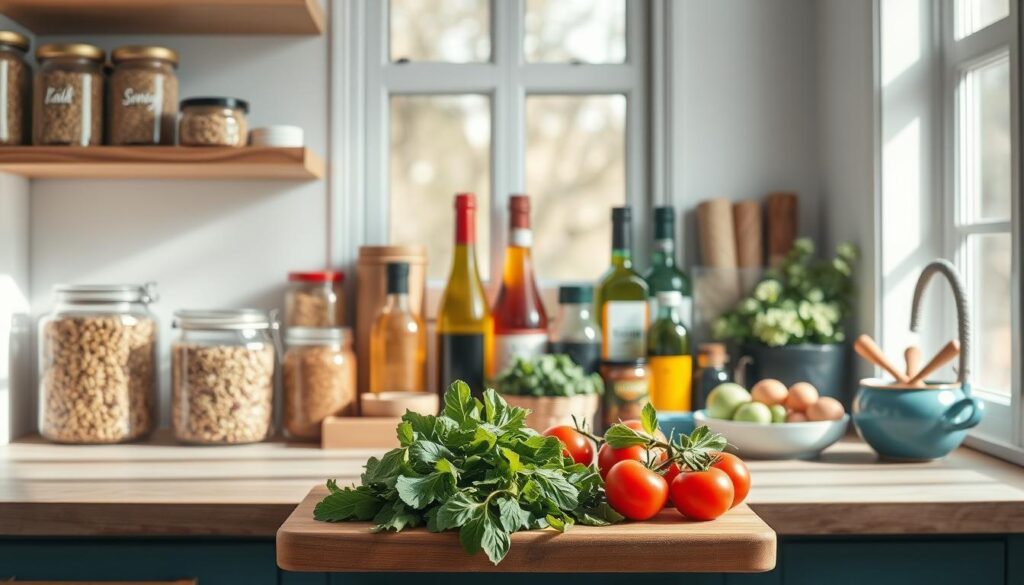
Take tomato sauce: this humble jar transforms into three distinct dishes. Simmer it with garlic for spaghetti, blend into soup, or layer with beans for a quick skillet shakshuka. Pair crusty bread with olive oil for dipping, or toast slices for crunchy croutons. Versatility hides in everyday items.
| Pantry Hero | Uses | Meal Example |
|---|---|---|
| Canned Tomatoes | Soups, sauces, stews | 10-minute marinara over spaghetti |
| Whole-Grain Bread | Sandwiches, croutons, strata | Avocado toast with chili flakes |
| Dried Pasta | Stir-fries, salads, casseroles | Garlic-oil spaghetti with kale |
During a hectic week last fall, my canned tomato stash saved dinner four nights straight. From chili to flatbread pizzas, each meal felt fresh despite using similar base ingredients. That’s the magic of strategic stocking—it lets creativity thrive even under pressure.
Carb options like bread and spaghetti anchor meals while stretching proteins and veggies. A University of Michigan study found households with diverse grain supplies ate 23% more vegetables weekly. Your shelves aren’t just storing food—they’re building better habits.
Mastering Lunch Meal Prep Pantry Staples
Ever opened your cupboard and seen possibilities instead of just cans? That shift happens when you learn to wield shelf-stable heroes like olive oil and black beans like kitchen tools. These foundational items become building blocks for nourishing bowls, wraps, and salads that defy the “boring” stereotype.
Let’s talk about liquid gold—olive oil. A drizzle transforms canned black beans into vibrant salads when tossed with cumin and lime. Use it to sauté garlic for instant flavor bases or whisk with vinegar for zesty dressings. I keep two varieties: everyday for cooking, and a fruity bottle for finishing dishes.
Black beans shine when treated as more than taco fillers. Try these ideas:
- Mash with spices for protein-packed sandwich spreads
- Toss with roasted sweet potatoes and quinoa
- Simmer into 10-minute chili with canned tomatoes
Balanced dishes emerge naturally when combining core components. Pair beans with whole grains like farro, add crunch from jarred peppers, and brighten with citrus. One reader shared how mixing black beans with brown rice and frozen corn became her teen’s after-school favorite—proof that simplicity wins.
Your shelves hold endless combinations. Start with three ingredients you love, then rotate one element weekly. Try swapping olives for sun-dried tomatoes in grain bowls, or using chickpeas instead of black beans. The goal? Make your staples work for you, not the other way around.
Essential Ingredients for Quick Lunches
Three ingredients sit in my kitchen, ready to rescue any hectic day: rice, pasta, and beans. These humble heroes form the backbone of countless dishes, offering texture, protein, and comfort without fuss. Pair them with vibrant sauces and crisp vegetables, and you’ve got a plate that satisfies both hunger and creativity.
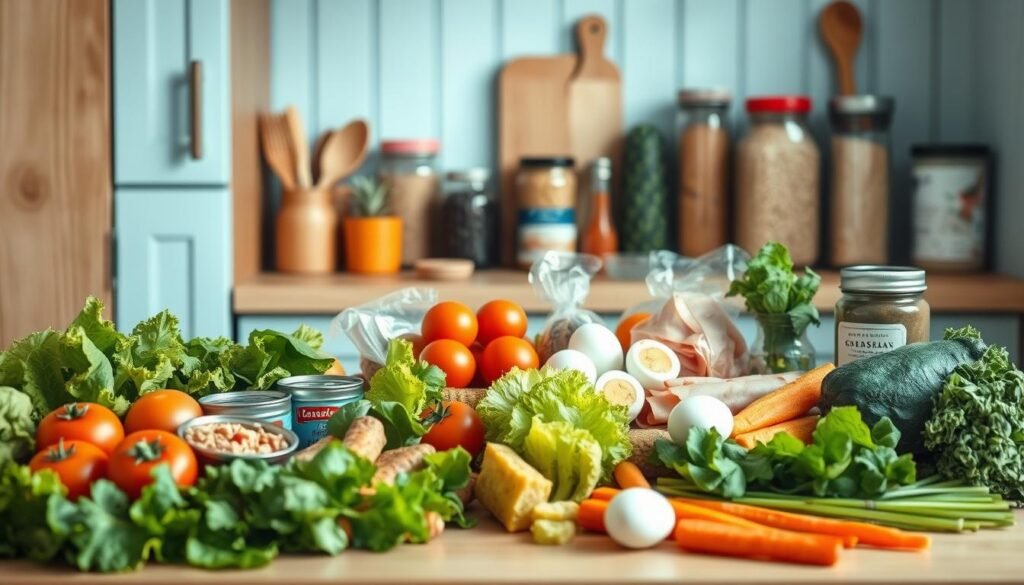
Staple Items: Rice, Pasta, and Beans
These shelf-stable items work like culinary chameleons. Rice becomes fried “bowls” with frozen peas and soy sauce. Pasta morphs into garlicky aglio e olio or a cold salad with jarred artichokes. Beans? Mash them for spreads or simmer into chili. Their versatility lies in neutral flavors that absorb bold seasonings.
| Base Ingredient | Prep Time | Flavor Boosters |
|---|---|---|
| Brown Rice | 25 mins | Turmeric, lime zest, sesame oil |
| Whole-Grain Pasta | 12 mins | Pesto, sun-dried tomatoes, pine nuts |
| Black Beans | 2 mins (canned) | Chipotle powder, cilantro, avocado |
Incorporating Vegetables and Proteins
Frozen spinach and roasted red peppers add color without prep time. Canned tuna or chickpeas deliver protein in minutes. For sauces, keep a rotation of tahini dressing, marinara, and spicy variations to transform basics into exciting plates.
My go-to formula: 1 cup base + ½ cup veggies + palm-sized protein + 2 tbsp sauce. Rotate components weekly—try edamame instead of beans, or swap zucchini ribbons for spinach. It’s about building, not following strict recipes.
Quick Meal Ideas Using Pantry Staples
Canned tuna isn’t just for sandwiches—it’s your shortcut to vibrant, protein-packed dishes in minutes. I once raced against the clock to feed hungry kids before soccer practice. A can of tuna, whole-grain crackers, and lemon juice became crispy “fish bites” they devoured. That’s the power of creative pairing.
Allrecipes features a 5-minute Mediterranean tuna salad mixing olives, artichokes, and olive oil. Serve it over greens or stuff into pita pockets. For warmer days, try Food Network’s chilled pasta toss: fusilli, tuna, capers, and jarred roasted peppers.
| Base Ingredient | Add-Ins | Prep Time | Source |
|---|---|---|---|
| Canned Tuna | Lemon, dill, Greek yogurt | 7 mins | EatingWell |
| Quinoa | Tuna, frozen peas, soy sauce | 15 mins | BBC Good Food |
| Whole-Grain Wraps | Tuna, hummus, pickled onions | 5 mins | Allrecipes |
Need crunch? Top tuna melts with crushed potato chips like Bon Appétit suggests. Or mix tuna with mashed white beans for a creamy dip. Fresh herbs or citrus zest elevate these combos without grocery trips.
One reader shared her genius hack: “I keep pre-chopped celery in the freezer for tuna salads—game-changer!” Rotate between spicy (sriracha mayo) and tangy (apple cider vinegar) versions to keep taste buds guessing.
Your shelves hold endless potential. Swap tuna for sardines in pasta dishes, or add sun-dried tomatoes to grain bowls. With smart pairings, every bite stays exciting—even on chaotic afternoons.
Creative Recipes for Grab-and-Go Lunches
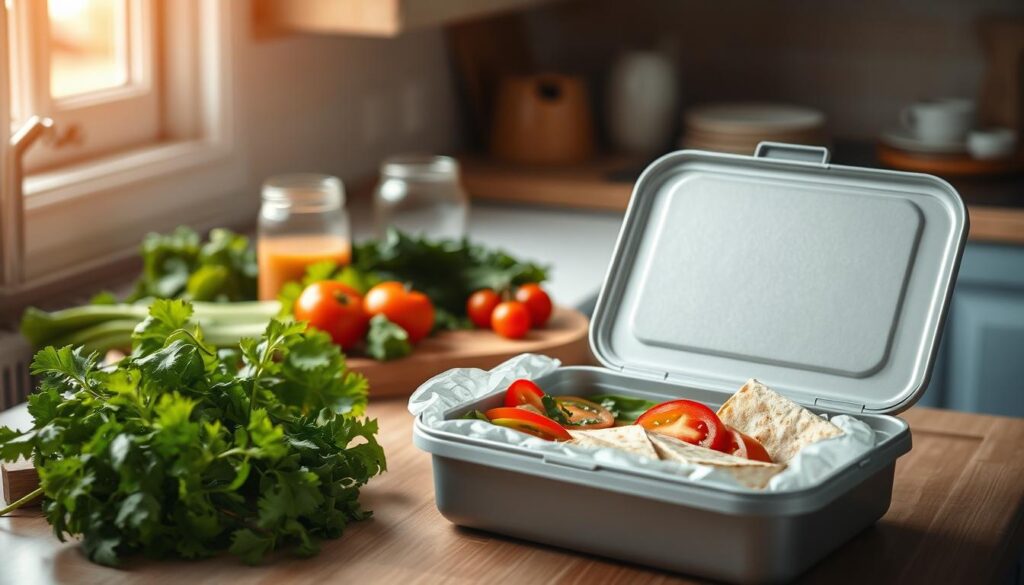
Your morning rush doesn’t have to mean bland sandwiches. Let’s talk about cheese—not just cheddar slices, but crumbled feta stirred into couscous with sun-dried tomatoes, or smoked gouda melted into whole-grain wraps. These combos turn rushed mornings into flavor adventures without extra prep time.
Last week, I transformed leftover rice into Korean-inspired bowls using gochujang (find it in the international aisle) and sesame seeds. Topped with quick-pickled veggies from a jar, it proved fusion dishes don’t need fancy ingredients—just bold spices and creativity.
Try these twists on classics:
- Mediterranean chickpea wraps: hummus + canned chickpeas + diced tomatoes + za’atar seasoning
- Tex-Mex quinoa cups: cooked quinoa + black beans + shredded cheese + chili powder baked in muffin tins
- Curried egg salad: Greek yogurt + hard-boiled eggs + curry powder + golden raisins
Smoked paprika turns roasted tomatoes into Spanish-style bruschetta topping. Crumbled feta adds tang to jarred roasted peppers and olives for Greek-inspired pasta salads. As chef Yotam Ottolenghi advises:
“Play with contrasts—creamy against crunchy, sweet beside spicy.”
Keep a cheese rotation (sharp aged cheddar, creamy goat, salty halloumi) to mix textures. Pair with shelf-stable stars like marinated artichokes or dried apricots. Your midday break just got tastier.
Leveraging Canned and Jarred Goods
Ever faced an empty fridge and still pulled together a satisfying dish? That’s the superpower of canned tomatoes, tuna, and beans. These kitchen warriors work quietly in your cupboard, ready to shine when fresh options run low or time evaporates.
During a winter storm last year, my canned tomato stash became roasted red pepper soup, shakshuka, and marinara—all while snowed in. As the USDA notes, these items retain nutrients for up to two years, making them ideal for freezer-adjacent storage when space is tight.
Strategic Flavor Boosters
Jarred goods cut cooking time by skipping prep steps. Pair canned tuna with capers and lemon for zesty salads, or simmer beans with cumin for instant taco filling. Keep diced onions in the freezer to add depth to sauces without chopping.
Try these combos from trusted sources:
- Allrecipes’ 15-minute chili: canned beans + tomatoes + frozen onions
- Food52’s pantry pasta: jarred artichokes + tuna + olive oil
- Bon Appétit’s white bean dip: canned beans + roasted garlic + lemon
One reader shared her genius hack: “I keep caramelized onions in jars—they turn canned soup into gourmet fare.” These ingredients adapt to whatever your week throws down, whether it’s last-minute guests or forgotten grocery runs.
Rotate between three core canned items monthly, storing extras in the freezer during sales. Your future self will relish the extra time and creative freedom when deadlines loom. After all, dinner shouldn’t be a scramble—it should be your quiet victory.
Enhancing Meals with Sauces, Spices, and Seasonings
A drizzle of sauce can turn roasted veggies into a vibrant feast, while a pinch of smoked paprika resurrects yesterday’s rice. The magic lies in balancing foundational elements like oil, eggs, and broth—your toolkit for transforming humble ingredients into crave-worthy dishes.
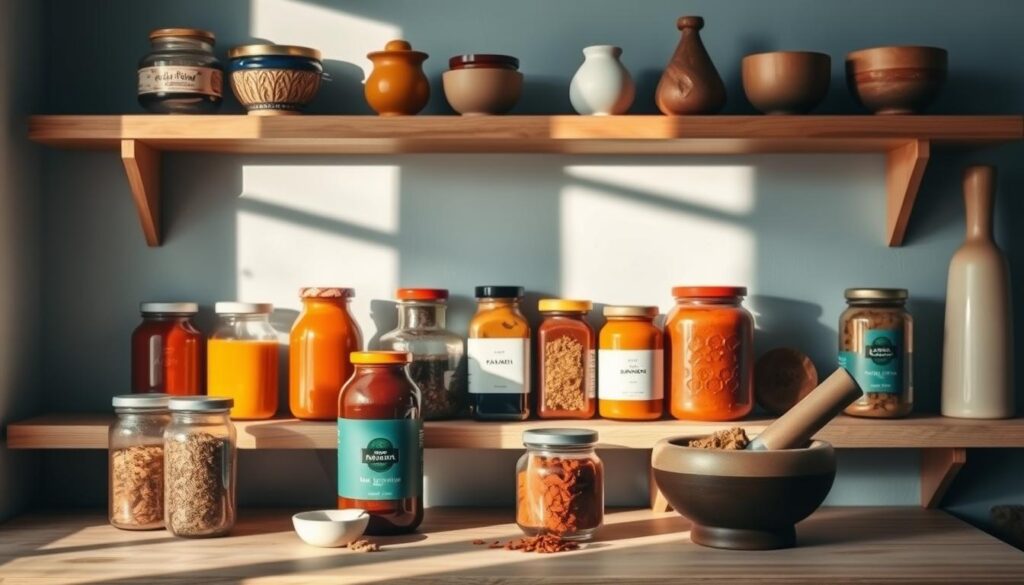
Homemade Sauce Hacks
Start with oil as your canvas. Whisk lemon juice into olive oil for a bright vinaigrette, or infuse chili flakes in warm oil for spicy pasta tosses. For creaminess without dairy, blend silken tofu with roasted garlic—a trick I used during a dairy-free month that became a permanent staple.
When time’s tight, try these three-step sauces:
- Golden broth glaze: Simmer vegetable broth with honey and ginger until syrupy
- Lemon-herb aioli: Mix mayo with lemon zest and dried tarragon
- 5-minute carbonara: Whisk eggs with grated cheese and black pepper
Essential Seasoning Tips
Salt early, taste often. Season grains while cooking to embed flavor deep within. For soups using canned beans or broth, add acidity (vinegar or citrus) at the end to brighten without overpowering.
As chef Samin Nosrat advises:
“Salt is a magnifier. Use it to highlight what’s already great in your ingredients.”
| Seasoning Blend | Best With | Pro Tip |
|---|---|---|
| Smoked Paprika + Cumin | Roasted veggies, beans | Add to oil before sautéing |
| Lemon Pepper + Dill | Eggs, fish | Mix into Greek yogurt for dips |
| Garlic Powder + Thyme | Soups, sauces | Bloom in warm broth |
Keep tasting spoons handy. Adjust ratios as you go—more honey if too sharp, extra oil if too tangy. Your shelves hold endless possibilities when you view spices as flavor architects rather than afterthoughts.
Organizing Your Pantry for Efficient Meal Prep
Chaotic shelves lead to chaotic cooking. I learned this the hard way when a jar of peanut butter tumbled onto my spice collection during a busy week. Now, my pantry works like a well-oiled machine—ingredients visible, accessible, and ready for action. Start by grouping similar items: oils with oils, grains with grains, proteins like canned shrimp in their own zone.
Organization Strategies
Clear bins transformed my kitchen workflow. Store roasted vegetables in airtight containers on eye-level shelves, while lesser-used items like holiday spices go higher. Use painter’s tape labels with expiration dates—a trick I borrowed from restaurant kitchens. Web checklists from The Kitchn recommend dedicating zones:
| Zone | Items | Access Frequency |
|---|---|---|
| Quick Grab | Oils, spices, nuts | Daily |
| Protein Station | Canned shrimp, beans, peanut butter | 3x/week |
| Vegetable Hub | Jarred peppers, canned vegetables | 2x/week |
Maintenance and Rotation Tips
Adopt the “first in, first out” rule. Place newer items behind older ones to prevent forgotten lentils from expiring. Every month, do a 10-minute audit:
- Check dates on broths and sauces
- Discard stale items (we’ve all had that mystery grain bag)
- Restock roasted vegetables or freeze-dried fruits
Chef Ina Garten’s advice sticks with me:
“An organized kitchen isn’t about perfection—it’s about creating flow.”
Keep a marker near shelves to note when you’re low on essentials like frozenvegetablesor quick-thaw proteins. Your future self will reclaim precious minutes during hectic evenings.
Budget-Friendly Meal Prep Ideas
What if I told you that $10 could fuel three flavorful lunches? Stretching ingredients becomes effortless when you treat ground proteins and spice mixes as your culinary workhorses. During my early catering days, I learned that smart combinations—like blending lentils with ground turkey—create hearty dishes without breaking the bank.
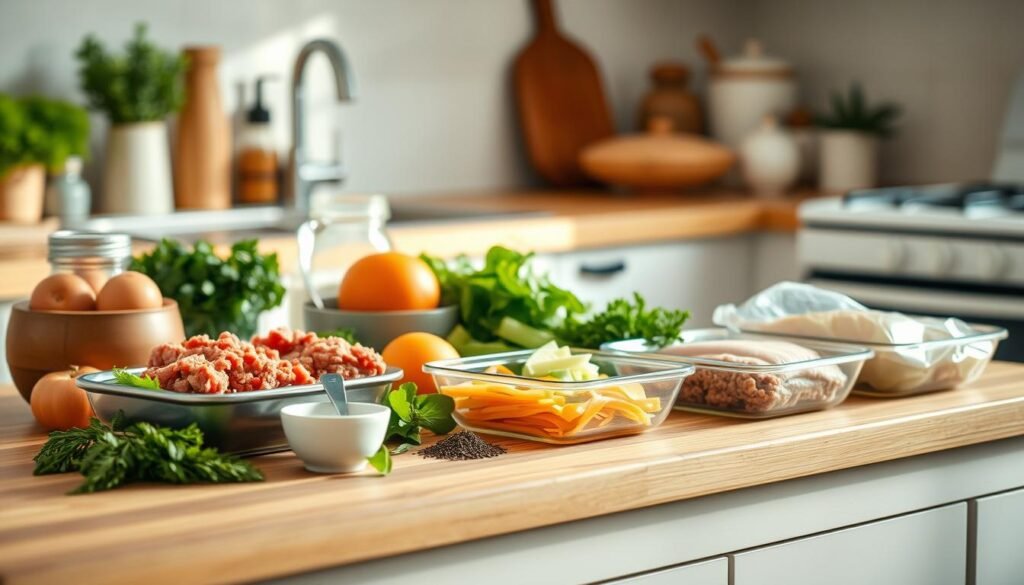
Start with versatile bases. A pound of ground chicken becomes three meals: stir-fry lettuce wraps, chili, and stuffed peppers. Pair with dollar-store finds like canned tomatoes and frozen corn. As Budget Bytes founder Beth Moncel notes:
“Flavor thrives in simplicity. A $1 spice blend can transform $3 worth of ingredients into something special.”
Use these building blocks for maximum impact:
| Ingredient | Cost per Serving | Meal Ideas |
|---|---|---|
| Ground Beef (93% lean) | $1.20 | Taco bowls, meat sauce, stuffed zucchini |
| Butter Beans | $0.75 | Mashed spreads, skillet hash, veggie burgers |
| Frozen Veggie Mix | $0.50 | Fried rice, soup enhancer, frittata filler |
Don’t underestimate the power of butter. A pat melted into canned tomatoes creates rich pasta sauce, while browned butter drizzled over roasted carrots elevates side dishes. For creamy texture without heavy cream, mix a tablespoon into mashed beans.
One reader shared her genius hack: “I freeze herb stems in olive oil cubes—they add gourmet flair to cheap cuts!” Rotate between three core proteins weekly and let sauces do the heavy lifting. Your wallet—and taste buds—will thank you.
Incorporating Fresh and Frozen Ingredients
Ever tossed roasted potatoes into a pantry-based dish and watched it transform? Fresh and frozen elements bridge the gap between convenience and nourishment. A USDA study shows households blending shelf-stable items with produce consume 34% more nutrients weekly—proof that balance creates better plates.
Potatoes shine here. Roast them with olive oil and rosemary, then pair with canned white beans for a hearty skillet hash. Frozen spinach? Thaw and mix into jarred marinara for instant pasta sauce depth. The magic lies in cooking techniques that unite textures:
- Roast potatoes until crispy, then toss with chickpeas and tahini
- Sauté frozen peas with garlic, mixing into microwave-ready rice
- Blend frozen mango with canned coconut milk for quick smoothie bowls
Salad creativity blooms when combining pantry stars with fresh crunch. Try massaged kale with canned salmon, sunflower seeds, and lemon—or mix cooked quinoa with roasted sweet potatoes and dried cranberries. As one reader shared: “Adding fresh herbs to canned soups makes them taste like I simmered them all day.”
| Pantry Base | Fresh/Frozen Boost | Meal Idea |
|---|---|---|
| Canned lentils | Diced potatoes | Curried lentil-potato bowls |
| Jarred pesto | Frozen broccoli | Pesto pasta with roasted veggies |
| Dried couscous | Fresh parsley | Herbed couscous salad |
Experiment with ratios. Start with 50% pantry items and 50% fresh/frozen—adjust based on what’s available. Potatoes add staying power to meals, while frozen berries brighten oatmeal without prep. Your cooking routine becomes both efficient and exciting when shelves and freezer collaborate.
Time-Saving Techniques for Busy Weekdays
Time crunches don’t have to mean sacrificing flavor or nutrition. During my busiest catering seasons, I discovered that smart shortcuts—like pre-chopped garlic and jarred salsa—turn frantic evenings into streamlined cooking sessions. The secret? Treat your kitchen like a relay race, passing tasks between future-you and present-you.
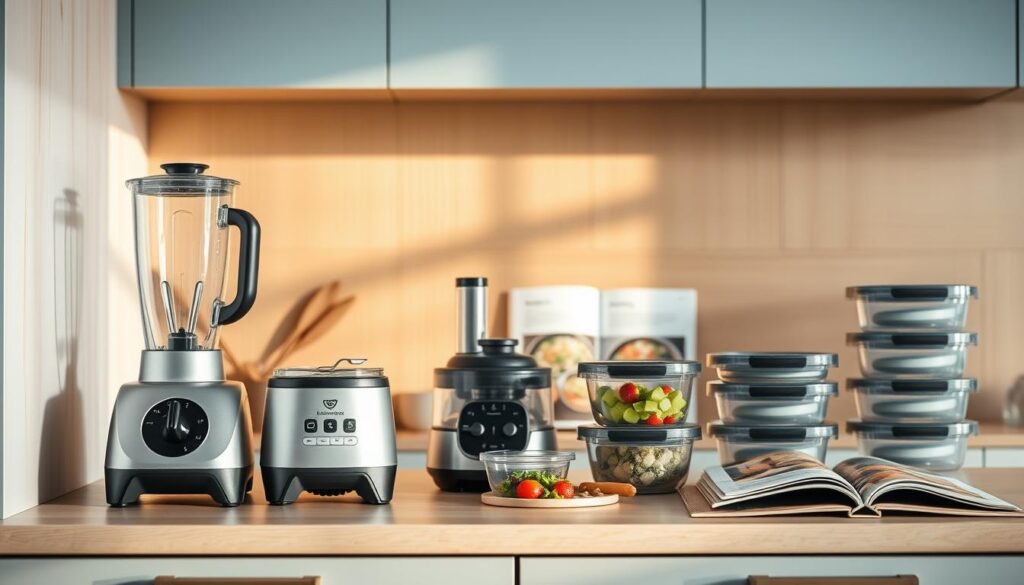
Flavor-First Shortcuts
Batch-roast three trays of beans every Sunday—chickpeas, black beans, and white beans. Store them seasoned but plain, ready to adapt to any dish. Toss with salsa for instant tacos, or simmer with broth for quick soups. Pre-minced garlic (found in jars) saves 5 minutes per recipe—time better spent helping kids with homework or decompressing.
| Hack | Time Saved | Meal Impact |
|---|---|---|
| Freeze salsa in ice cubes | 2 mins/serving | Instant flavor for scrambled eggs or rice |
| Cook beans in bulk | 45 mins/week | 3 protein bases ready |
| Pre-mix spice blends | 4 mins/day | Zero measuring during cooking |
Allrecipes’ test kitchen director notes:
“Strategic prep turns ‘What’s for dinner?’ into ‘Dinner’s adapting to my schedule.’”
Last month, I transformed a can of beans and jarred salsa into five meals—including enchilada stuffed sweet potatoes and salsa-braised chicken. Small steps create big wins. Keep your cutting board clean, your tools accessible, and your expectations flexible. Your weeknights just got tastier.
Creative Ways to Use Leftovers
Leftovers aren’t a compromise—they’re your next culinary canvas. Last week, I transformed extra roasted veggies and lentils into crispy fritters that disappeared faster than I could plate them. This mindset shift turns yesterday’s grains and proteins into today’s flavor adventures.
Stale bread becomes croutons. Cooked lentils morph into veggie burgers when mixed with oats and smoked paprika. For texture contrast, add crushed walnuts or sunflower seeds. As chef Yotam Ottolenghi suggests:
“Leftovers are ingredients in disguise—they just need a little imagination to shine.”
Try these reinventions:
| Leftover | Transformation | Flavor Boost |
|---|---|---|
| Mashed lentils | Stuffed peppers | Feta + lemon zest |
| Cooked rice | Fried rice cakes | Sriracha mayo drizzle |
| Roasted veggies | Grain bowl base | Tahini dressing |
One reader shared her genius hack: “I freeze leftover chili in muffin tins—perfect portions for burger patty binders!” For more strategies, explore our guide on maximizing leftovers.
Spices reset flavors. Toss reheated grains with curry powder and raisins for a Moroccan twist. Mix shredded chicken with BBQ sauce and slaw for sandwich upgrades. Your fridge holds endless potential—you just need to see it differently.
Expert Advice from Trusted Web Sources

Great cooking isn’t about secret recipes—it’s about smart borrowing from those who’ve mastered the craft. Bon Appétit’s food editors swear by one golden rule: “Always taste as you go, especially when working with simple ingredients.” A pinch of freshly cracked pepper can brighten canned soups, while roasted seasonal veggies add texture to grain bowls.
Chef Michael Symon emphasizes balancing flavors in pantry meals:
“Acidity cuts through richness. A splash of vinegar or squeeze of lemon turns basic beans into something special.”
Food Network’s test kitchen recommends keeping three pepper varieties on hand—black for heat, white for sauces, and smoked for depth.
Trusted sources agree on these strategies:
- Choose whole spices over pre-ground for longer-lasting aroma
- Pair frozen veggies with bold seasonings (think garlic + chili flakes)
- Layer textures using crunchy nuts or crispy roasted chickpeas
| Ingredient Tip | Expert Source | Flavor Impact |
|---|---|---|
| Fresh vs. frozen veggies | EatingWell | Retain 90% nutrients when flash-frozen |
| Toasting spices | America’s Test Kitchen | Doubles aroma in under 3 minutes |
| Pepper grind size | Cook’s Illustrated | Coarse grind = bolder flavor |
Seasonal produce makes even basic food shine. Epicurious suggests visiting farmers’ markets for inspiration—swap jarred mushrooms for fresh sautéed greens. As one reader shared: “Adding charred spring onions to canned lentils made my family ask for seconds!”
Remember: Expert food wisdom isn’t reserved for chefs. Start with one technique—like blooming spices in oil—and build from there. Your shelves hold endless potential when paired with trusted guidance.
Building Balanced and Nutritious Meals
Balanced plates start with smart pairings, not perfect recipes. During a chaotic week last summer, I discovered that combining black beans with sautéed ground beef created a protein-packed base for tacos, stuffed peppers, and grain bowls. The key? Treat each component like puzzle pieces—they should complement without competing.
Start with a simple formula: 40% veggies, 30% protein, 30% grains. For example, roasted zucchini (veggies) + seasoned black beans (protein) + quinoa (grains). Add crunch with toasted seeds or tang with pickled onions. This approach ensures variety in every bite while maximizing nutrients.
| Protein | Grain | Veggie Boost |
|---|---|---|
| Black beans | Brown rice | Roasted bell peppers |
| Ground beef | Couscous | Sautéed spinach |
| Lentils | Farro | Shredded carrots |
Don’t underestimate flavor twists. A spoonful of peanut butter stirred into coconut milk creates a rich satay sauce for grain bowls. Or mix it with soy sauce for a nutty dressing over black bean salads. These small additions elevate dishes from routine to remarkable.
Portion control becomes effortless with compartmentalized containers. Fill half with colorful veggies, then divide the remaining space between proteins like ground beef and grains. For more easy healthy meals, explore our favorite combos that balance taste and nutrition without fuss.
Your kitchen’s hidden potential lies in jars and cans waiting to become today’s triumph. A thoughtfully stock pantry isn’t just about ingredients—it’s about reclaiming time and creativity when life gets loud.
Through trial and error (like my infamous “garlic overkill” chili phase), I’ve learned that success lives in simplicity. Keep jars of olive oil handy for instant dressings or sautéed greens. Rotate grains and proteins to keep flavors fresh without extra shopping trips.
Remember: Those cans of beans and tomatoes? They’re your culinary safety net. Pair them with frozen veggies or crusty bread for meals that feel planned, even when thrown together mid-deadline. As one reader shared, “My stock pantry helped me feed surprise guests without panic—they thought I’d cooked all day!”
Now it’s your turn. Drizzle olive oil over roasted chickpeas for crunch. Mix jarred peppers into grain bowls. Share your wins—like turning lentils into burger patties or crafting 10-minute soups—in our community forum. Because great cooking isn’t about perfection. It’s about having tools ready when inspiration (or chaos) strikes.
Crispy Tuna Rice Cakes with Lemon-Herb Yogurt
Golden, crunchy rice cakes topped with flavorful tuna and a refreshing lemon-herb yogurt sauce—perfect for a light lunch or elegant appetizer.
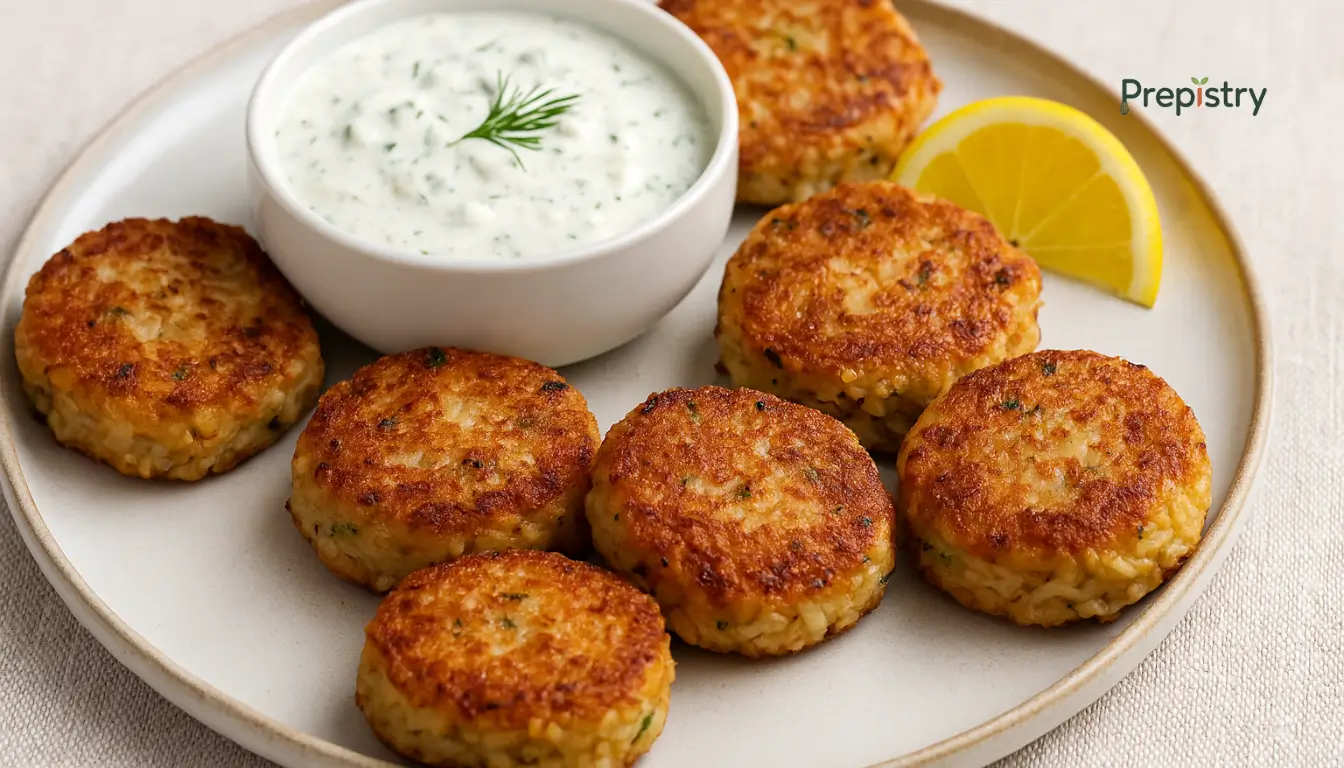
Nutrition Information
Equipment Needed
- Mixing bowls
- Non-stick skillet
- Spatula
- Measuring cups and spoons
Ingredients
-
1 cup cooked sushi rice
-
1 can (5 oz) tuna in water, drained
-
1/4 cup finely chopped green onions
-
1 tablespoon soy sauce
-
1 teaspoon sesame oil
-
1/2 cup plain Greek yogurt
-
1 tablespoon lemon juice
-
1 teaspoon chopped fresh dill
-
1 teaspoon chopped fresh parsley
-
Salt and pepper to taste
-
2 tablespoons vegetable oil for frying
Instructions
Recipe Video
How to Make Crispy Tuna Rice Cakes with Lemon-Herb Yogurt
Learn how to prepare delicious crispy tuna rice cakes topped with a refreshing lemon-herb yogurt sauce in this step-by-step tutorial.

